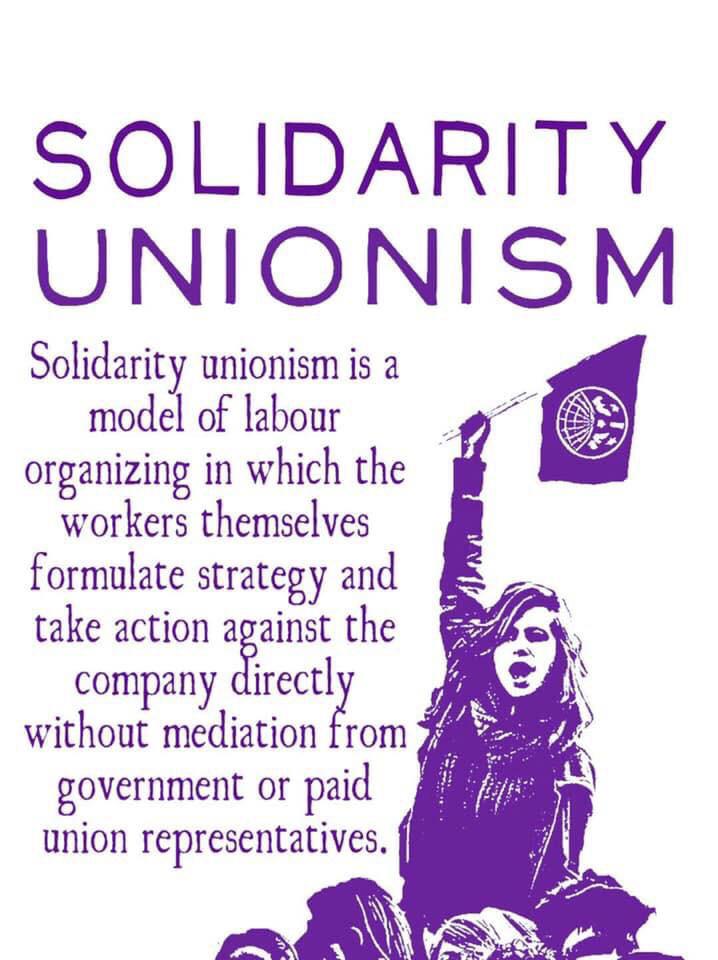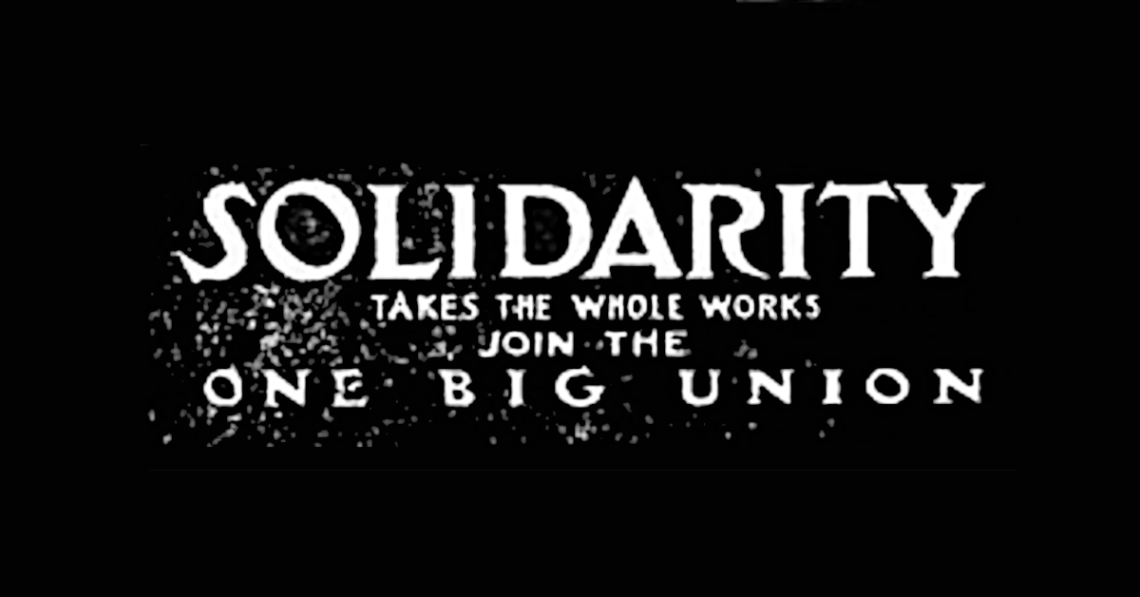By Lexi Owens, IU620, Seattle General Membership Branch
The IWW sets itself apart from other unions in North America through two principles: the call for the abolition of the wage system and its replacement by industrial democracy; and “solidarity unionism” –the democratic and militant organizing philosophy that guides successful branches. Although the IWW helped inspire the concept of solidarity unionism, and although what we practice now resembles the original usage of the term, in the last two decades we have adopted and evolved solidarity unionism. The concept has taken on new meaning in the context of our current campaign strategies and our Organizer Training Program.
Lawyer and labor activist Staughton Lynd coined the term “solidarity unionism” in 1990. He argued that solidarity unionism is essential to rebuilding the labor movement “from below” –democratically, in opposition to both the undemocratic business unions (for example, those in the American Federation of Labor) and the undemocratic and destructive concentration of wealth held by capitalists. He defines solidarity unionism as rank-and-file organizing that uses collective action to win demands and eschews legalistic strategies such as NLRB elections, no-strike clauses and dues checkoff in contracts, and reliance on professional contract negotiators. He developed the concept of solidarity unionism following the actions of the Workers’ Solidarity Club of Youngstown, Ohio, which facilitated organization of rank-and-file workers, unemployed workers, and retirees to make demands in parallel to the existing unions in Youngstown’s community. The Workers’ Solidarity Club gave organizers the chance to work outside the usual union grievance procedure in a way that empowered the workers most affected by their employers’ misdeeds.
Today, solidarity unionism refers to the bedrock of our organizing: workers democratically decide what actions to take against the employer in order to win demands without interference from union bureaucrats or the government. Solidarity unionism empowers workers by helping them to organize the union most useful for their own workplace while also preventing the kind of top-down, staff-driven approaches of mainstream unions. This approach fosters, preserves, and strengthens union militancy through collective action.

Former General Secretary-Treasurer Alexis Buss applied “solidarity unionism” to the IWW’s anti-capitalist ideals. In 2002, Buss expressed doubts regarding the prevalent “minority unionism” approach, when a small group of Wobblies would take direct action and try to win demands but without the goal of winning an NLRB election or majority support of the workers. Already, key aspects of solidarity unionism were present, but Buss began looking for a term that could encapsulate the heart of minority unionism while growing beyond its limitations. The answer, she argued, “isn’t to settle for a minority clique of agitators in each workplace. It’s to form meaningful, organized networks of solidarity capable of winning improvements.” Such drastic demands would necessitate majority support across shops, industries, and whole economies.
Buss was also a central figure in the development of the Organizer Training Program (Organizer Training 101 and 102). Marianne Garneau wrote a history of the OTP, saying, “The impetus for the training program was yet another ‘let’s get serious’ moment in the late 1990s and early 2000s, with campaigns springing up around the union; the training was an attempt to deliver best practices to do-it-yourself, boom-and-bust campaigns.” Training manuals that pre-dated the 101/102 were an amalgamation of direct-action tactics, other unions’ organizing guidance, and legalistic union strategies. But Wobblies had trouble grafting the IWW’s vision onto losing tactics from mainstream unions, and many IWW campaigns struggled to win elections and maintain stable presences in shops. In response, Buss put together the first OT101 in 2002. The program has since evolved, and with it, the concept of solidarity unionism in the IWW has solidified.
The OTP adapts by learning from successes and mistakes, regular revisions to the curriculum, and democratic participation and oversight from trainers and participants. The OTP now teaches a radical and democratic program that puts “solidarity unionism” into practice. When we conceptualize solidarity unionism now, we no longer mean a power structure built in parallel to the legal rules regarding union recognition, nor parallel to the traditional union grievance procedure. Instead, we practice solidarity unionism as the means to organize majority (and eventually wall-to-wall) support in a shop because impactful collective actions can be taken–and bigger demands won–when a majority of workers are organized into taking action together. Solidarity unionism makes demands of us, as organizers, because we are tasked with involving as many workers in the union as possible, guaranteeing democratic decision-making regarding grievances and actions and working-class solidarity that reaches all workers in a workplace (and eventually in an industry).
Lexi Owens is a freelance tutor and full-time parent based out of the Seattle GMB.
References:
Solidarity Unionism: Rebuilding the Labor Movement from Below by Staughton Lynd, 2nd Edition, 2015. PM Press.
Solidarity Unionism at Starbucks by Staughton Lynd and Daniel Gross, 2011. PM Press.
“Between Scylla and Charybdis” by Marianne Garneau and Lexi Owens, Organizing.Work, August 28 2020. https://organizing.work/2020/08/between-scylla-and-charybdis/
“A History of the IWW’s Organizer Training Program” by Marianne Garneau, Organizing.Work, September 17 2020. https://organizing.work/2020/09/a-history-of-the-iwws-organizer-training-program/
“A Cheatsheet for Comparing Organizing Models” by Marianne Garneau, Organizing.Work, January 16 2020. https://organizing.work/2020/01/organizing-strategy-comparison/
“Minority Report #1” by Alexis Buss, Industrial Worker, July 2002. https://archive.iww.org/about/solidarityunionism/explained/minority1/
“Minority Report #2” by Alexis Buss, Industrial Worker, October 2002. https://archive.iww.org/about/solidarityunionism/explained/minority2/
“Minority Report #3” by Alexis Buss, Industrial Worker, November 2002. https://archive.iww.org/about/solidarityunionism/explained/minority3/
“Minority Report #4” by Alexis Buss, Industrial Worker, December 2002. https://archive.iww.org/about/solidarityunionism/explained/minority4/
“Minority Report #5” by Alexis Buss, Industrial Worker, June 2003. https://archive.iww.org/about/solidarityunionism/explained/minority5/

